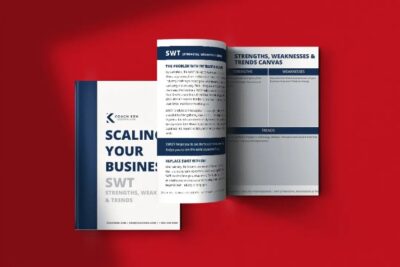
Giving a hard, truthful look at your business model, and industry will illuminate your business’s underlying strengths and weaknesses.
Understanding why others buy from your competitors deepens your understanding of your own business. It’s important to understand that your customers’ needs are often not what you think they are.
Deep exploration of your customers, context, and business will bring fresh insights to help you scale, as it will provide you with a better sense on how you can make the future work for you.
THE PROBLEM WITH THE TRADITIONAL S.W.O.T
By definition, the SWOT (Strengths, Weaknesses, Opportunities, Threats) process drives leaders to look inward at their company and industry challenges, creating more of an internal reflection of the company and industry. While helping executives see the forest and the trees, the traditional SWOT analysis tends to lead them to forget that there’s a world outside the forest. With this introspective focus, WOT doesn’t spot the trends in other industries and distant markets that CEOs must factor into their plans.
SWOT analysis still has a place in the strategic planning process. It’s a useful tool for gathering ideas and input from people inside your organization who are more internally focused and closer to the day-to-day operations. However, as a top executive looking to scale your business, it’s imperative that you’re thinking on a higher strategic level.
S.W.O.T helps you to see the forest from the trees, S.W.T helps you to see the world beyond the forest.
REPLACE SWOT WITH S.W.T
Alternatively, for business owners and CEOs looking to scale for the future and earn more market share, replacing SWOT with the SWT model (Strengths, Weaknesses, Trends) can focus on inherent strengths and weaknesses while exploring broader external trends beyond their industry or geography.
STRENGTHS & WEAKNESSES (SW)
All businesses have innate strengths and weaknesses. Managing both strengths and weaknesses is less about changing them and more about playing the hand the organization was dealt with. The keyword is inherent because the SWT model focuses on strengths and weaknesses that are relatively fixed. SW in the SWT model is about acknowledging with brutal honesty where your company’s strengths and weaknesses stand in context to the bigger picture of the global landscape.
Strengths reflect the core competencies of the company: the inherent sources of success through time. Executives need to be crystal clear on the organization’s inherent strengths or core competencies that has been the source of its success. By writing this down, you will have a clear understanding of the drivers of your business’ success and how you can counter your inherent weaknesses.
Weaknesses are inherent to the company and are highly unlikely to change through time. For example, this could be where your business is situated which could make it challenging to attract a specific customer segment. Being clear on inherent weaknesses will poise you to think about how you can compensate with your strengths and how growing or future trends help your business fill gaps.
TRENDS (T)
Signals from the future are all around you. Trends and competitors will often only give you part of the picture. And, if you’re only following what your competitors are doing, you risk missing something really important. You need a contextual frame that goes beyond the competitive landscape.
Understanding your context will give you a clear picture of today’s trends and weak signals that will shape tomorrow. This kind of contextual assessment includes understanding market trends, emerging technologies, rules and regulations, economic climate, customer needs, competitors, and even uncertainties. It’s important to not think about these signals, trends, facts, and competitors within the scope of your current business. To really paint the picture you’ll need for the future, go wider than your business.
As a business owner or executive, you should look at major trends, such as significant changes in technology, distribution, product innovation, markets, and social developments around the country or world that might shake up not only the business but the entire industry.
Forget about the competitor down the street. Is there a company on the other side of the globe that might put you out of business? Is there a new technology that could lead to an overnight change in the way companies in your industry might do business? These are the kinds of questions the strategic thinking team must explore.
Who are the nascent competitors? What are you uncertain about that might affect your future context? A global pandemic? Buying behaviour, technology?
Download S.W.T: Scaling Your Business EBOOK.
Gain fresh insights by following the SWP model to better understand how you can bulletproof your business from the competition and future trends.


